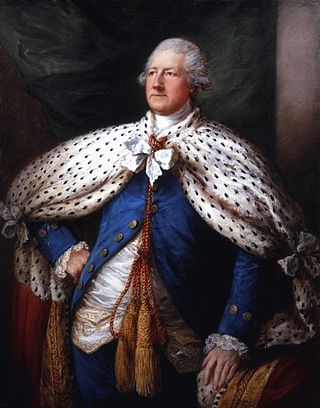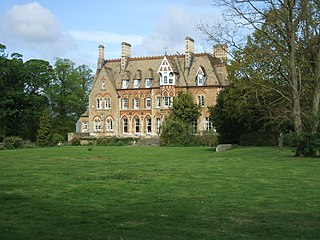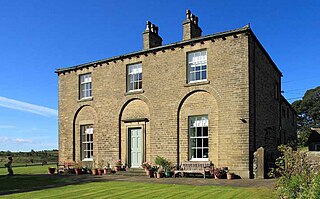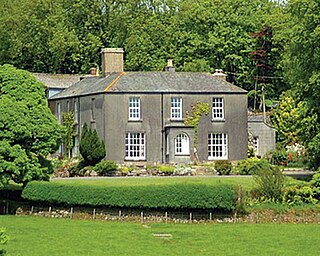
Blakeney is a coastal village and civil parish in the English county of Norfolk. Blakeney lies within the Norfolk Coast AONB and the North Norfolk Heritage Coast. The North Norfolk Coastal Path travels along its quayside. The village is 21.1 mi (34 km) north west of Norwich, 4.6 mi (7.4 km) NNW of the larger settlement of Holt, 11.5 mi (18.5 km) west of Cromer and 112 mi (180 km) NNE of London.

Sir Thomas Fowell Buxton, 1st Baronet Buxton of Belfield and Runton was an English Member of Parliament, brewer, abolitionist and social reformer. He married Hannah Gurney, whose sister became Elizabeth Fry, and became a great friend of her father Joseph Gurney and the extended Gurney family.

John Hobart, 2nd Earl of Buckinghamshire was a British nobleman and politician.

Little Cressingham lies 2.5 miles (4.0 km) south east by road from Great Cressingham, 3 miles (4.8 km) west of Watton and 8 miles (13 km) south of Swaffham in the Breckland District of Norfolk. It covers an area of 11.90 km2 (4.59 sq mi) and had a population of 157 in 70 households at the 2001 census It is in the civil parish of Great Cressingham. The village is located on the edge of the Stanford Battle Area.

Harbord Harbord, 1st Baron Suffield, known as Sir Harbord Harbord, Bt, between 1770 and 1786, was a British landowner and politician who sat in the House of Commons from 1756 to 1784 when he was raised to the peerage as Baron Suffield.

Wood Hall Hotel and Spa, Trip Lane, is an AA four-star, 44-room country house hotel with an AA two-rosette restaurant, about one mile from the English village of Linton, West Yorkshire. A Grade II listed building that was once owned by the Vavasour and Scott families.

Dunston Hall Hotel is an Elizabethan Revival style Grade II listed building in the village of Dunston, Norfolk, England. It is part of the QHotels Collection group of hotels and has an AA four-star rating.

Hoveton Hall in the parish of Hoveton in Norfolk is a Regency-style country house made of gault brick with a slate roof. It was built between 1809 and 1812, on or near the site of the previous ancient manor house of the same name, by Mrs Christabell Burroughes (1764-1843), daughter and heiress of Henry Negus (1734-1807) of Hoveton Hall, an attorney, and wife of James Burkin Burroughes (1760-1803) of Burlingham Hall, Norfolk. The architect was Humphry Repton. It is a well-preserved historic house of significance on the English Heritage Register. The Negus family had been seated at Hoveton Hall for several generations. The surrounding estate today consists of 120 acres of gardens and parkland and 450 acres of arable land as well as picturesque woodland. The gardens are open to the public during part of the year and there are facilities available for accommodation and special events including weddings.

Milton Ernest Hall is a large grade I listed country house in the village of Milton Ernest, Bedfordshire, England. It now serves as a nursing home.

Wadhurst Castle is a 19th-century castellated mansion just to the west of the town of Wadhurst, East Sussex, England, in an elevated position overlooking the countryside to the south. It is a grade II listed building.

The Manor of Groves Hotel in High Wych, near Sawbridgeworth in Hertfordshire is a building of historical significance and is listed as Grade II on the English Heritage Register. It was remodelled over an existing older building in 1823 by a prominent London lawyer. The house was a private residence for many distinguished people over the next 150 years and in 1988 was converted to a hotel. It still serves this function and provides accommodation, dining facilities and caters for events such as conferences and weddings. There is also a golf course.
Richard Lestrange of Hunstanton and King's Lynn, Norfolk; later of Kilkenny, Ireland, was an English politician.

Bayfield Hall is a Grade II* listed building which stands in a small estate close to the village of Letheringsett and the hamlet of Glandford in the English county of Norfolk within the United Kingdom. The house that stands today was built in the last part of the 18 century replacing an earlier manor house thought to have been built in the 16 century. That house had been constructed of an early medieval manor house.

Newton Grange in Bank Newton, Skipton, in Yorkshire is a Georgian house of historical significance and is Grade II listed on the English Heritage Register. It was built in about 1800 by Richard Greenwood, a gentleman, and was the private residence for many notable families. It is now a wedding venue and provides holiday cottage accommodation.

Penyard House, Weston under Penyard near Ross-on-Wye is a building of historical significance. It appears to have been built in about 1821 by a wealthy landowner John Partridge. It was the home of many notable residents for the next century until it was converted to a hotel in the 1930s. The hotel, which provided restaurant services and catered for special events, closed in mid 2020 during the COVID-19 pandemic and did not reopen.

Morston Hall in the parish of Morston near Holt, Norfolk, is a building of historical significance. The original house was built in about 1640 and cellars and chimneys from it survive. It was substantially altered in the 18th century and a wing was added in the 19th century. It was owned by the Townshend viscounts from Raynham Hall from the 17th century until 1911 and during this time it was tenanted by various notable people. Today it is a hotel. It also caters for special events particularly weddings.

Burnville House in Brentor, West Devon, England, is a building of historical significance and is Grade II listed on the English Heritage Register. It was built in about 1800, possibly by William Sleman, who was a wealthy landowner and described as "a gentleman". It was the home of several notable families over the next two centuries. Today it provides bed and breakfast accommodation and has self-catering cottages.

Stanley House in Mellor, Lancashire, England, is a building of historical significance and is Grade II* listed on the English Heritage Register. It was built in the late 16th or early 17th century and was the home of notable people for many years. However, by the early 19th century, the status of the house sank to that of a rented farmhouse. Farming activity continued over the next two centuries with tenant farmers being the occupants. In 1999 the land and buildings were then purchased by Leehand Leisure Ltd, and they converted the building to a hotel and spa which opened in 2003.

The Eden House Hotel is a building of historical significance in Grantham, Lincolnshire, England. It was built as a mansion in about 1850 and for many years was called Little Gonerby House and after that Diana Lodge. It was the home of several notable people over the next century. Today it is a hotel.

Thomas Poyntz was an English merchant resident in Antwerp in the sixteenth century. He was a member of the Worshipful Company of Grocers.

























